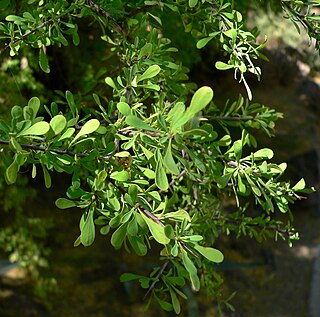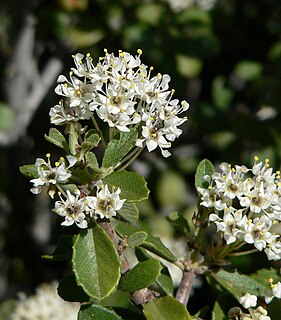
Symphoricarpos, commonly known as the snowberry, waxberry, or ghostberry, is a small genus of about 15 species of deciduous shrubs in the honeysuckle family, Caprifoliaceae. With the exception of the Chinese coralberry, S. sinensis, which is indigenous to western China, all species are native to North and Central America. The name of the genus is derived from the Ancient Greek words συμφορεῖν (sumphoreîn), meaning "to bear together", and καρπός (karpós), meaning "fruit". It refers to the closely packed clusters of berries the species produces.

Conocarpus erectus, commonly called buttonwood or button mangrove, is a mangrove shrub in the family Combretaceae. This species grows on shorelines in tropical and subtropical regions around the world.

Colubrina is a genus of about 30 species of flowering plants in the family Rhamnaceae, native to warm temperate to tropical regions of Africa, the Americas, southern Asia, northern Australia, and the Indian Ocean islands. Common names include nakedwood, snakewood, greenheart and hogplum. The generic name is derived from the Latin word coluber, meaning "snake", and refers to the snake-like stems or stamens.

Condalia is a genus of spiny shrubs in the tribe Rhamneae of the buckthorn family, Rhamnaceae. It was named for Antonio Condal, an 18th Spanish physician. Members of the genus are native to tropical and subtropical deserts and xeric shrublands in North and South America. The ranges of each species vary considerably; some are confined to only a few square miles, while others can be found on an area up to 1,000 sq mi (2,600 km2).

Grevillea acanthifolia, commonly known as the Acanthus-leaved grevillea, is a plant in the family Proteaceae and is endemic to New South Wales. It is a shrub with stiff, prickly, divided leaves and pink to purple "toothbrush" flowers.

Condalia globosa, also called bitter condalia, or bitter snakewood, is a perennial shrub, small tree of the family Rhamnaceae.

Ceanothus cordulatus is a species of shrub in the family Rhamnaceae known by the common names mountain whitethorn and whitethorn ceanothus. It is native to California and adjacent sections of Oregon, Nevada, and Baja California, where it grows on mountain ridges and other forested areas. This is a spreading shrub growing usually wider than tall and up to about 1.5 meters. The stems are gray, with the twigs yellow-green in color and fuzzy in texture when new. The evergreen leaves are alternately arranged and up to 3 centimeters long. Each is oval in shape with three ribs and generally not toothed. The leaves may be hairy or not. The inflorescence is panicle-shaped, up to about 4 centimeters long. The flowers are white to off-white with five sepals and five petals. The fruit is a rough, ridged capsule up to half a centimeter long. It has three valves inside, each containing a seed. It is a nitrogen-fixing plant, that is uniquely abundant in old-growth forest conditions when compared to similar types of nitrogen-fixing plants. In addition, Ceanothus cordulatus is known to be an important source of nitrogen patches for significantly longer times than other similar post-disturbance successional shrubs, following disturbance events such as forest fires.

Ceanothus greggii, known by the common name desert ceanothus, is a species of flowering shrub in the buckthorn family, Rhamnaceae. It is native to the Southwestern United States and northern Mexico, where it grows primarily in desert scrub, sagebrush, chaparral, and other dry habitats such as inland mountain slopes, at elevations of 1,000 m (3,300 ft) to 2,300 m (7,500 ft).

Petrophile linearis, commonly known as pixie mops, is a species of flowering plant in the family Proteaceae and is endemic to southwestern Western Australia. It is a shrub with narrow egg-shaped leaves, the narrower end towards the base, and oval to spherical heads of hairy, greyish-pink or mauve to almost white flowers.
Cephalanthus salicifolius is a species of flowering plant in the family Rubiaceae. Common names include Mexican buttonbush, mimbre, botoncillo, and Jazmin blanco. Its native range extends from the banks of the southernmost stretch of the Rio Grande in Cameron and Hidalgo Counties of Texas through much of Mexico from Coahuila to Oaxaca; a disjunct population exists in Honduras.

Psorothamnus arborescens is a species of flowering plant in the legume family known by the common name Mojave indigo bush.

Colubrina asiatica is a shrub in the family Rhamnaceae that is native to tropical and subtropical regions of the Old World, from eastern Africa to India, southeast Asia, tropical Australia, and the Pacific Islands. Common names include latherleaf, Asian nakedwood and Asian snakewood.

Symphoricarpos albus is a species of flowering plant in the honeysuckle family known by the common name common snowberry. It is native to North America, where it occurs across much of Canada and the northern and western United States.

Ziziphus obtusifolia is a species of flowering plant in the buckthorn family known by several common names, including lotebush, graythorn, gumdrop tree, and Texas buckthorn.

Rhamnus alaternus is a species of flowering plant in the buckthorn family Rhamnaceae, known by the common names Italian buckthorn or Mediterranean buckthorn. It is a hardy medium-sized evergreen shrub with fragrant flowers.

Berberis haematocarpa, Woot. with the common names red barberry, red Mexican barbery, Colorado barberry and Mexican barberry, is a species in the Barberry family in southwestern North America. It is also sometimes called algerita, but that name is more often applied to its relative, Mahonia trifoliolata.

Petrophile anceps is a species of flowering plant in the family Proteaceae and is endemic to a restricted part of southwestern Western Australia. It is a shrub with sharply-pointed, linear leaves and oval heads of hairy yellow flowers.
Petrophile incurvata is a species of flowering plant in the family Proteaceae and is endemic to southwestern Western Australia. It is a shrub with flattened, sometimes pinnately-divided leaves with up to five sharply pointed lobes, and cylindrical to oval heads of silky-hairy, cream-coloured to yellowish-white flowers.
Petrophile latericola is a species of flowering plant in the family Proteaceae and is endemic to southwestern Western Australia. It is an erect shrub with needle-shaped leaves and spherical heads of bright yellow flowers.

Vexatorella latebrosa, also known as the Robertson vexator, is an evergreen, upright shrub of up to about 1½ m high, from the family Proteaceae. It has entire, long inverted egg-shaped, bluish grey, leathery leaves that are line-shaped to very narrowly spade-shaped in outline, 5–6½ cm (2.0–2.6 in) long and 2–3 mm (0.08–0.12 in), and mostly solitary globular flower heads at the end of the branches of 2½–3 cm (0.8 in) across with scented, pink to carmine flowers with extended, styles with a thickened tip. The plants are flowering from August to September. It is an endemic species that is restricted to the Western Cape province of South Africa.
















